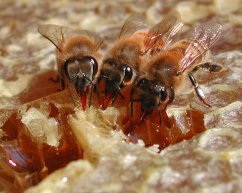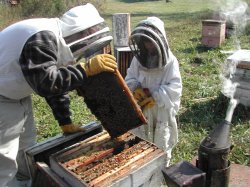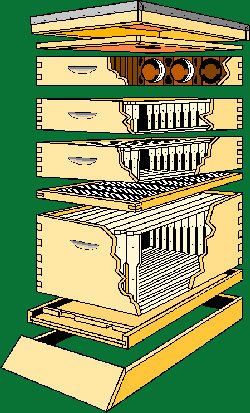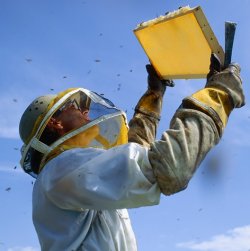
Humans have kept honeybees for hundreds of years and hunted
honey for thousands of years. Our relationship with the honeybee is
a complex one but important to our specie's current food
requirements. Initially, man hunted for honey bee nests in trees
and stole the honey. Eventually they stole the tree, took the hive
portion home, and learned to take only some honey to keep the
colony alive as well. Soon the honeybee was even more understood
and man could divide colonies by catching swarms and placing them
in man-made cavities like hollow logs (gum hive), straw baskets
(skep hive), or clay pots. Honey and larvae (yes, people ate that,
too) became more abundant to the human diet but still required
severe harm or death to the honey bee colony. It wasn't until the
year 1851 that an American reverend discovered a practical solution
that no longer harmed the honeybees and revolutionized beekeeping
forever.

Rev. Lorenzo Lorraine Langstroth is considered the "Father of
American Beekeeping." Rev. Langstroth was born December 25, 1810
and died October 6, 1895. He was first a clergyman and teacher, but
is best known as a beekeeper.
Honeybees are extremely hygienic and orderly creatures. They
tend to cover surfaces with propolis (sterile) and build comb into
every available nook and cranny available to them. L. L. Langstroth
noticed a uniformity in how the honey bee built its comb and, after
some experimentation, discovered "bee space". Bees will build comb
no deeper than allows a space of 1 cm from the opposite surface.
This happens to be the amount of space required for two bees to
work comfortably back-to-back.

So, by building woodware to allow for this, Langstroth developed
the Moveable Frame Hive. With a moveable frame hive, each honey
comb is surrounded by a wooden frame and, because they're spaced
based on "bee space", the bees don't glue the frames together or
build comb between frames. This allows a beekeeper to remove a
frame, examine it, and replace it without harming any bees or their
labours.
The Langstroth Hive is based on a box that contains 10 frames
and is open on the top and bottom. The different parts of the hive
are stacked to form a column that starts with a bottom board and is
closed on top by a lid. The size and composition of the entire
structure can be altered to allow for growth during abundance
periods and reduced for winter dormancy. The Langstroth hive is
still the most commonly used bee equipment used today. Many places
(including Ontario) have made it illegal to keep bees in any
container that does not use moveable frames as part of their bee
protection policies.

The cache is not at the posted coordinates. To find this
cache, complete the following:
45 18.(how old was L.L. Langstroth when he
discovered bee space?)N
074 38.(how old was L.L. Langstroth when he
died + 650)W
There's about 40 meters of light bushwhacking to GZ. Once you're
done, please think like a beekeeper and, after closing up things
the way you found them, place the stone back on the lid to avoid
gusty wind removal.
This cache is one of several on the
Glengarry Trail
System.
Congrats to Inkyfiller for being the FTF!